2000 HONDA PASSPORT fuel
[x] Cancel search: fuelPage 200 of 267
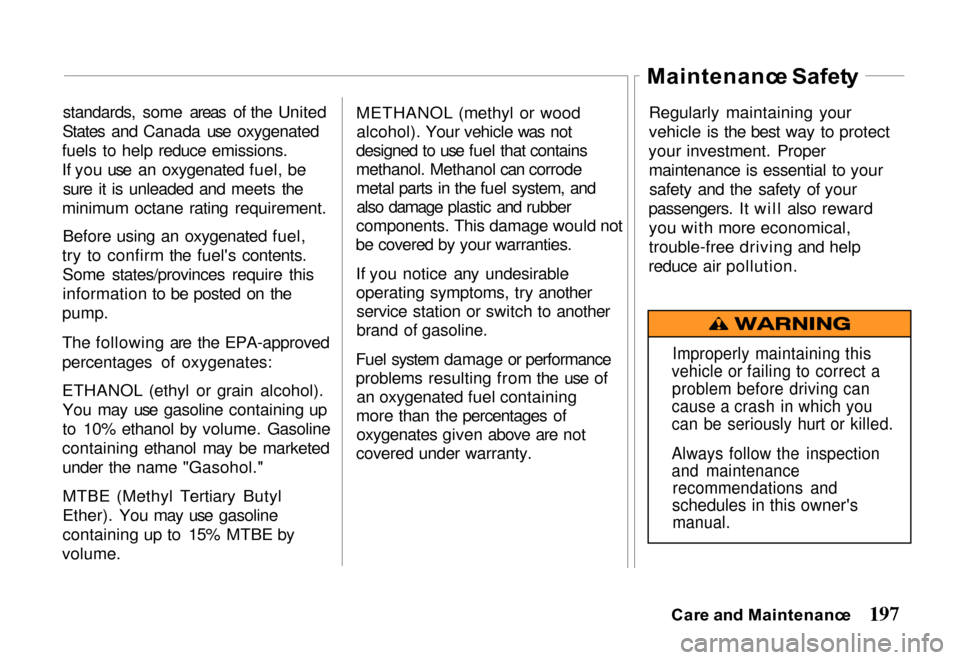
standards, some areas of the United
States and Canada use oxygenated
fuels to help reduce emissions.
If you use an oxygenated fuel, be sure it is unleaded and meets the
minimum octane rating requirement.
Before using an oxygenated fuel,
try to confirm the fuel's contents. Some states/provinces require this
information to be posted on the
pump.
The following are the EPA-approved
percentages of oxygenates:
ETHANOL (ethyl or grain alcohol). You may use gasoline containing up
to 10% ethanol by volume. Gasoline
containing ethanol may be marketed under the name "Gasohol."
MTBE (Methyl Tertiary Butyl
Ether). You may use gasoline
containing up to 15% MTBE by
volume. METHANOL (methyl or wood
alcohol). Your vehicle was not
designed to use fuel that contains
methanol. Methanol can corrode
metal parts in the fuel system, and also damage plastic and rubber
components. This damage woul d not
be covere
d by your warranties.
If you notice any undesirable
operating symptoms, try another service station or switch to another
brand of gasoline.
Fuel system damage or performance
problems resulting from the use of an oxygenated fuel containing
more than the percentages of oxygenates given above are not
covered under warranty. Regularly maintaining your
vehicle is the best way to protect
your investment. Proper maintenance is essential to yoursafety and the safety of your
passengers. It will also reward you with more economical,
trouble-free driving and help
reduce air pollution.
Car e an d Maintenanc e
Maintenanc
e Safet y
Improperly maintaining this
vehicle or failing to correct a problem before driving can
cause a crash in which you
can be seriously hurt or killed.
Always follow the inspection
and maintenance recommendations and
schedules in this owner's
manual.
Page 201 of 267
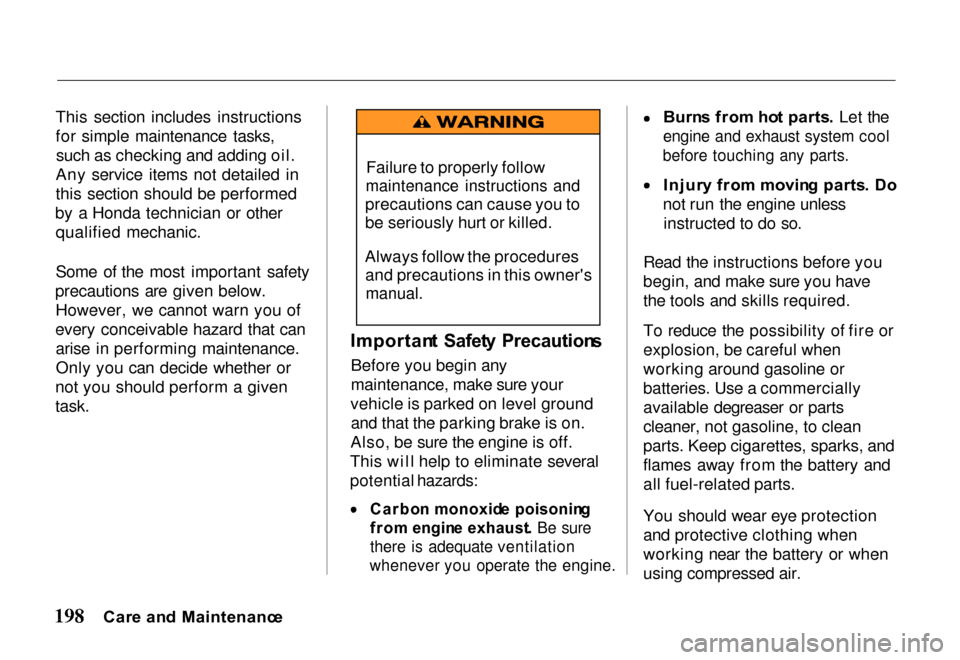
This section includes instructions
for simple maintenance tasks,
such as checking and adding oil.
Any service items not detailed in
this section should be performed
by a Honda technician or other qualified mechanic.
Some of the most important safety
precautions are given below. However, we cannot warn you of
every conceivable hazard that can arise in performing maintenance.
Only you can decide whether or
not you should perform a given
task.
Importan
t Safet y Precaution s
Before you begin any
maintenance, make sure your
vehicle is parked on level ground and that the parking brake is on.
Also, be sure the engine is off.
This will help to eliminate several
potential hazards:
Carbo
n monoxid e poisonin g
fro m engin e exhaust . Be sure
there is adequate ventilation
whenever you operate the engine.
Burn
s fro m ho t parts . Let the
engine and exhaust system cool
before touching any parts.
Injur y fro m movin g parts . D o
not run the engine unless instructed to do so.
Read the instructions before you
begin, and make sure you have
the tools and skills required.
To reduce the possibility of fire or
explosion, be careful when
working around gasoline or
batteries. Use a commercially
available degreaser or parts
cleaner, not gasoline, to clean
parts. Keep cigarettes, sparks, and
flames away from the battery and
all fuel-related parts.
You should wear eye protection
and protective clothing when
working near the battery or when
using compressed air.
Car e an d Maintenanc e
Failure t
o properly follow
maintenance instructions and
precautions can cause you to
be seriously hurt or killed.
Always follow the procedures and precautions in this owner's
manual.
Page 203 of 267

Maintenanc
e Schedul e
Check oil and coolant level, at each fuel stop. Under severe driving conditions, service these items more often.
* 1 Using SAE 10W-40 oil, or any viscosity other than those recommended, may reduce engine life and affect the warranty.
* 2 This service is recommended only.
Inspec
t monthly :
— These fluids: brake, clutch, PIS, battery, ATF, windshield washer
— Tire pressure
Car e an d Maintenanc e
R — Replace L — Lube I — Inspect After inspection, clean, adjust, repair or replace if necessary.
Page 204 of 267

R — Replace L — Lube I — Inspect After inspection, clean, adjust, repair or replace if necessary.
Check oi
l and coolant level at each fuel stop.
Under severe driving conditions, service these items more often. These conditions are: Service for severe driving conditions
Repeated short trips in cold weather Frequent idling and/or frequent low-speed operation Change engine oil and filter - Every 3,750 miles (6,000 km) Driving in dusty areas Towing a trailer or 3 months
Change rear axle oil - Every 15,000 miles (24,000 km)
Care an d Maintenanc e
Page 209 of 267
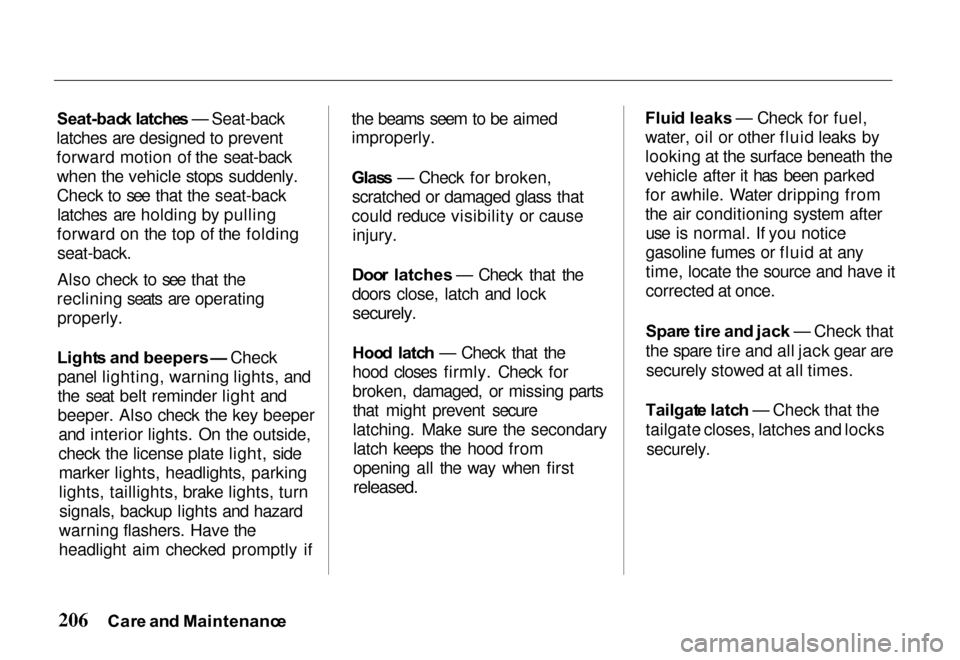
Seat-bac
k latche s — Seat-back
latches are designed to prevent
forward motion of the seat-back when the vehicle stops suddenly.
Check to see that the seat-backlatches are holding by pulling
forward on the top of the folding
seat-back.
Also check to see that the
reclining seats are operating properly.
Light s an d beepers — Check
panel lighting, warning lights, and
the seat belt reminder light and
beeper. Also check the key beeper and interior lights. On the outside,
check the license plate light, sidemarker lights, headlights, parking
lights, taillights, brake lights, turnsignals, backup lights and hazard
warning flashers. Have the
headlight aim checked promptly if the beams seem to be aimed
improperly.
Glas
s — Check for broken,
scratched or damaged glass that
could reduce visibility or cause injury.
Doo r latches — Check that the
doors close, latch and lock
securely.
Hoo d latc h — Check that the
hood closes firmly. Check for
broken, damaged, or missing parts that might prevent secure
latching. Make sure the secondarylatch keeps the hood from
opening all the way when first
released.
Flui
d leaks — Check for fuel,
water, oil or other fluid leaks by
looking at the surface beneath the
vehicle after it has been parked
for awhile. Water dripping from
the air conditioning system after use is normal. If you notice
gasoline fumes or fluid at any
time, locate the source and have it
corrected at once.
Spar e tir e an d jac k — Check that
the spare tire and all jack gear are securely stowed at all times.
Tailgat e latc h — Check that the
tailgate closes, latches and locks
securely.
Car e an d Maintenanc e
Page 210 of 267
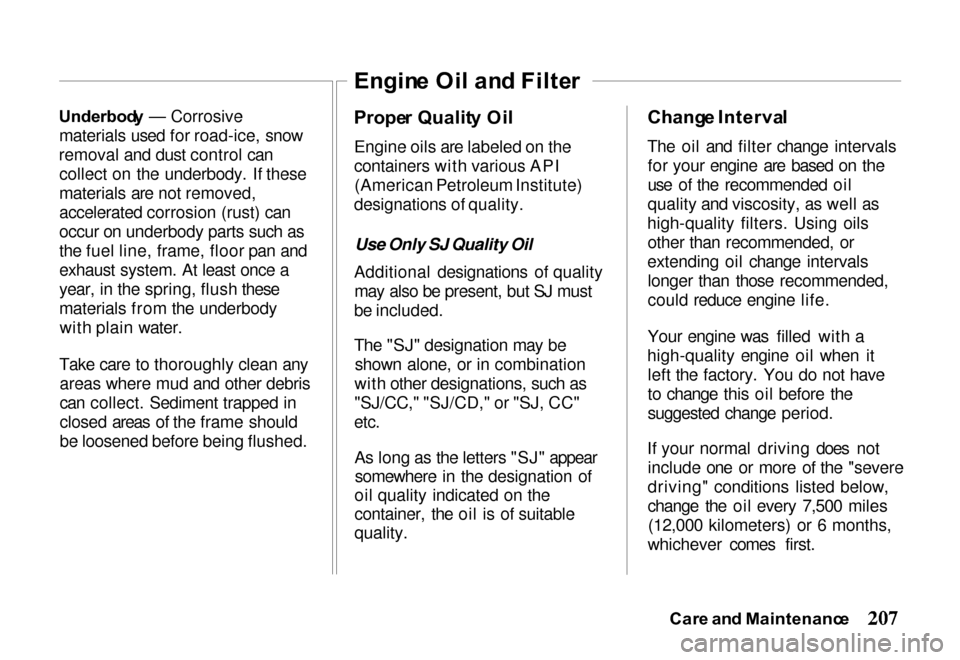
Underbod
y — Corrosive
materials used for road-ice, snow
removal and dust control can collect on the underbody. If these
materials are not removed,
accelerated corrosion (rust) can
occur on underbody parts such as
the fuel line, frame, floor pan and
exhaust system. At least once a
year, in the spring, flush these
materials from the underbodywith plain water.
Take care to thoroughly clean any areas where mud and other debris
can collect. Sediment trapped in
closed areas of the frame should
be loosened before being flushed. Prope
r Qualit y Oi l
Engine oils are labeled on the
containers with various API (American Petroleum Institute)
designations of quality.
Use Only SJ Quality Oil
Additional designations of quality may also be present, but SJ must
be included.
The "SJ" designation may be shown alone, or in combination
with other designations, such as
"SJ/CC," "SJ/CD," or "SJ, CC"
etc.
As long as the letters "SJ" appearsomewhere in the designation of
oil quality indicated on the
container, the oil is of suitable
quality. Chang
e Interva l
The oil and filter change intervals for your engine are based on the
use of the recommended oil
quality and viscosity, as well as
high-quality filters. Using oils other than recommended, or
extending oil change intervals longer than those recommended,
could reduce engine life.
Your engine was filled with a
high-quality engine oil when it left the factory. You do not have
to change this oil before the
suggested change period.
If your normal driving does not include one or more of the "severe
driving" conditions listed below,
change the oil every 7,500 miles(12,000 kilometers) or 6 months,
whichever comes first.
Car e an d Maintenanc e
Engin
e Oi l an d Filte r
Page 212 of 267
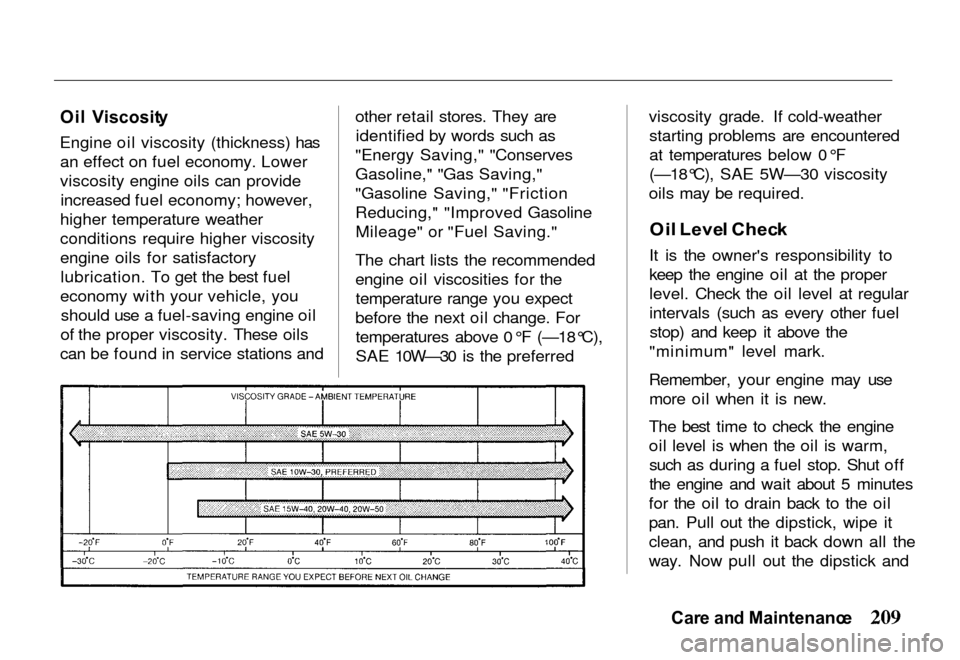
Oi
l Viscosit y
Engine oil viscosity (thickness) has an effect on fuel economy. Lower
viscosity engine oils can provideincreased fuel economy; however,
higher temperature weather
conditions require higher viscosity
engine oils for satisfactory lubrication. To get the best fuel
economy with your vehicle, you should use a fuel-saving engine oil
of the proper viscosity. These oils
can be found in service stations and other retail stores. They are
identified by words such as
"Energy Saving," "Conserves
Gasoline," "Gas Saving,"
"Gasoline Saving," "Friction
Reducing," "Improved Gasoline Mileage" or "Fuel Saving."
The chart lists the recommended
engine oil viscosities for the temperature range you expect
before the next oil change. For temperatures above 0°F (—18°C),
SAE 10W—30 is the preferred viscosity grade. If cold-weather
starting problems are encountered
at temperatures below 0°F
(—18°C), SAE 5W—30 viscosity
oils may be required.
Oi l Leve l Chec k
It is the owner's responsibility to
keep the engine oil at the proper
level. Check the oil level at regular
intervals (such as every other fuel stop) and keep it above the
"minimum" level mark.
Remember, your engine may use more oil when it is new.
The best time to check the engine
oil level is when the oil is warm, such as during a fuel stop. Shut off
the engine and wait about 5 minutes
for the oil to drain back to the oil
pan. Pull out the dipstick, wipe it
clean, and push it back down all the
way. Now pull out the dipstick and
Car e an d Maintenanc e
Page 221 of 267

Fron
t (4W D Only ) an d Rea r
Propelle r Shaf t
Lubricate the sliding yoke with
EP chassis grease. Lubricate
universal joints with grease
containing MoS 2 (molybdenum
disulfide-type grease) at the intervals shown in the
Maintenance Schedule. Also
check the propeller shaft
flange-to-pinion bolts for proper
torque of 64 N.m (46.3 Ib-ft).
Most lubrication recommendations
and procedures for four-wheel drive-
equipped vehicles are the same
for the corresponding components in conventional drive vehicles.
Exhaus t Syste m
Check the complete exhaust
system and nearby body areas for
damaged, missing, or
mispositioned parts, open seams, holes, loose connections, or other
deterioration that could allow
exhaust fumes to seep into the
passenger compartment or cause
heat build-up in the floor pan. Any
necessary corrections should be made immediately. For continuedsafety, exhaust system pipes and
resonators rearward of the muffler must be replaced whenever a new
muffler is installed.
Fue l Lin e an d Fue l Tank/Ca p
Inspect the fuel tank, cap and lines
for damage that could cause
leakage. Inspect the fuel cap and
gasket for correct sealing ability
and indications of physical
damage. Replace any damaged or
malfunctioning parts.
Driv
e Bel t
Check the belt driving the
alternator, power steering pump,
and air conditioning compressor.
Look for cracks, fraying, and wear. Replace as necessary.
Timin g Bel t
The timing belt should normally
be replaced at the intervals shown
in the Maintenance Schedule.
Valv e Clearanc e
Incorrect valve clearance will
result in increased engine noise and lower engine output, thereby
adversely affecting engine
performance.
Car e an d Maintenanc e